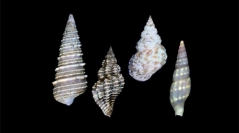

 Comptes Rendus Palevol
10 (2-3) - Pages 171-179
Comptes Rendus Palevol
10 (2-3) - Pages 171-179In order to characterize fossil species of molluscs, palaeontologists can only rely on shell morphology. The lack of many data used by biologists to describe the extant species of molluscs (e.g., anatomy, molecular sequences, colours, ecology, behaviour) represents an obstacle to understanding the structure of palaeobiodiversity structure and its evolution. Observation under ultraviolet light of residual colour patterns on the shells of numerous Caenozoic gastropods and bivalves provides a new set of characters that can enrich and refine the description of palaeontological species. The results using this new approach and various value perspectives (several thousands of species may show patterns, phylogenetic analyses, etc.) reveal the considerable potential of residual patterns for future work on the Caenozoic molluscs.
Residual colour patterns, Molluscs, Caenozoic, Palaeontological species